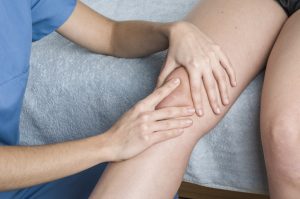Treatment Options for Patellar Tendinitis
 The patellar tendon works with muscles at the front of your thigh that you use to extend your knee when you kick, jump, and run. If you have knee pain, it could be due to an inflammation called patellar tendinitis.
The patellar tendon works with muscles at the front of your thigh that you use to extend your knee when you kick, jump, and run. If you have knee pain, it could be due to an inflammation called patellar tendinitis.
What Is Patellar Tendinitis?
Patellar tendinitis is an inflammation or injury to the patellar tendon that connects the kneecap (patella) to the shinbone (tibia). Pain can range from mild to severe depending on the extent of the problem.
You don’t have to be an athlete to get patellar tendinitis, but this condition is most commonly seen in people who participate in sports that require lots of jumping. Volleyball and basketball players frequently get patellar tendinitis, which is why it’s also called “jumper’s knee”.
What Causes Patellar Tendinitis?
Repetitive stress on the knee causes patellar tendinitis because it creates small tears in the tendon. Over time, these tears weaken the tendon and cause inflammation. Other factors that can lead to patellar tendinitis include:
- Being overweight
- Medical conditions that affect the tendon
- Tight leg muscles (quadriceps and hamstrings)
- An imbalance in leg muscle strength that creates an uneven pull on your patellar tendon
- Misalignment in the legs, feet, and ankles
- Playing sports on hard surfaces
- Shoes with insufficient padding
What Are the Symptoms for Patellar Tendinitis?
The main sign of patellar tendinitis is knee pain. The pain may start out mild, but it increases over time where it interferes with walking and climbing stairs. Swelling and burning sensations in the kneecap is another symptom. It could be especially painful for you to kneel or squat.
If you have persistent knee pain or discomfort, see your doctor. If your patellar tendonitis is treated early, you can make a fast and total recovery.
What Are the Treatments for Patellar Tendinitis?
Patellar tendonitis treatment depends on the severity of the injury. It's important to see a doctor for treatment. If you don't get medical care, you can worsen the damage to your tendon.
Conservative methods can help heal small or partial tears:
- Controlled periods of rest will be prescribed by your doctor
- Exercises that stretch & strengthen the leg muscles are typically also included in the first part of treatment
- Over-the-counter anti-inflammatory and pain relief medications may be recommended, such as ibuprofen, naproxen sodium, or acetaminophen
- Cortisone injections may also help relieve pain and improve mobility
- A patellar tendon strap that helps keep the pressure away from the tendon, directing the force through the strap instead
- Your doctor may recommend wearing a knee brace to keep the leg straight and promote healing
If conservative methods fail to relieve the pain or heal the tendon, or if the tear is a complete tear, knee surgery may be required. The surgery involves re-attaching the tendon to the kneecap.
If you are experiencing symptoms of knee pain or instability, the first step to better health is a consultation with an orthopedic specialist for diagnosis, treatment, and recovery. Dr. Burrus is an experienced fellowship-trained orthopedic surgeon who is dedicated to providing high-quality, specialized holistic care. Call 512.477.6341 or fill out the form on this page to schedule an appointment today.